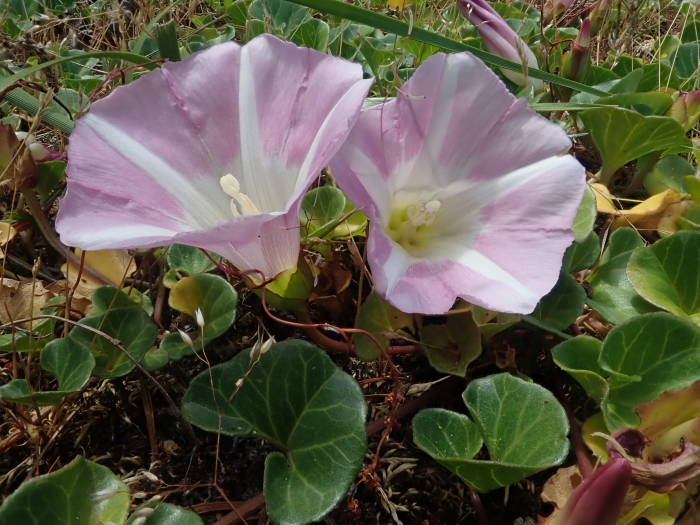Sea Bindweed
(Calystegia soldanella)
Sea Bindweed (Calystegia soldanella)
/
/

Nolan Exe
CC BY 4.0
Image By:
Nolan Exe
Recorded By:
Copyright:
CC BY 4.0
Copyright Notice:
Photo by: Nolan Exe | License Type: CC BY 4.0 | License URL: http://creativecommons.org/licenses/by/4.0/ | Rights Holder: Nolan Exe | Publisher: iNaturalist | Date Created: 2019-06-23T12:12:50-07:00 |
























Estimated Native Range
Summary
Calystegia soldanella, commonly known as sea bindweed, is a perennial vine notable for its ability to thrive in coastal habitats, including dunes and sandy shores. It is native to temperate regions worldwide, particularly along the west coast of North America, as well as the sandy coasts of England, Wales, Scotland, and Northern Ireland. This plant typically exhibits trailing, fleshy stems with kidney-shaped leaves and produces creamy-white to vivid lavender flowers that resemble those of morning glories, blooming from late spring to early autumn. The flowers are showy and attract pollinators such as bees and butterflies.
Sea bindweed is valued for its resilience in coastal garden settings, where it can stabilize sand and prevent erosion. Its salt tolerance makes it a suitable ground cover for seaside gardens. It prefers full sun to part shade and requires well-drained, sandy soil, reflecting its native dune habitat. While it is drought-tolerant, occasional watering can promote more vigorous growth. Gardeners should be cautious, as Calystegia soldanella can become invasive outside its native range, spreading rapidly and outcompeting native vegetation. It is important to monitor its growth and manage its spread to prevent it from becoming a problem.CC BY-SA 4.0
Sea bindweed is valued for its resilience in coastal garden settings, where it can stabilize sand and prevent erosion. Its salt tolerance makes it a suitable ground cover for seaside gardens. It prefers full sun to part shade and requires well-drained, sandy soil, reflecting its native dune habitat. While it is drought-tolerant, occasional watering can promote more vigorous growth. Gardeners should be cautious, as Calystegia soldanella can become invasive outside its native range, spreading rapidly and outcompeting native vegetation. It is important to monitor its growth and manage its spread to prevent it from becoming a problem.CC BY-SA 4.0
Plant Description
- Plant Type: Herb, Vine
- Height: 0.25-0.3 feet
- Width: 2-3 feet
- Growth Rate: Moderate
- Flower Color: Pink, White
- Flowering Season: Spring, Summer, Fall
- Leaf Retention: Deciduous
Growth Requirements
- Sun: Full Sun
- Water: Low
- Drainage: Fast, Medium
Common Uses
Drought Tolerant, Low Maintenance, Salt Tolerant, Showy Flowers
Natural Habitat
native to temperate regions worldwide, particularly along the west coast of North America, as well as the sandy coasts of England, Wales, Scotland, and Northern Ireland
Other Names
Common Names: Sea Bindweed, Beach Morning Glory, Плетуха Сольданелова, Beach Bindweed, Coast Morning Globy, Shore Bindweed
Scientific Names: , Calystegia soldanella, Calystegia asarifolia, Calystegia reniformis, Calystegia soldanella, Calystegia soldanella, Calystegia soldanella f. albiflora, Calystegia soldanella var. albiflora, Calystegia soldanella var. australis, Calystegia soldanelloides
GBIF Accepted Name: